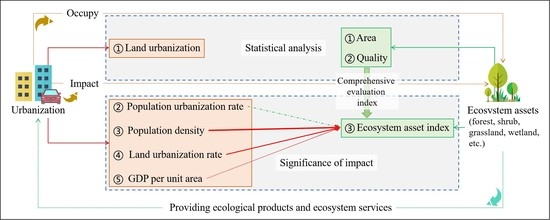Characteristics and Driving Mechanism of Regional Ecosystem Assets Change in the Process of Rapid Urbanization—A Case Study of the Beijing–Tianjin–Hebei Urban Agglomeration
Abstract
1. Introduction
2. Materials and Methods
2.1. Study Area
2.2. Data Source
2.3. Methods
2.3.1. Spatio-Temporal Change in Ecosystem Area
2.3.2. Landscape Pattern Indices
2.3.3. Ecosystem Asset Quality
2.3.4. Ecosystem Asset Indices
2.3.5. Urbanization Indicators
2.3.6. Correlation between Urbanization and Ecosystem Assets Change
3. Results
3.1. Changes in Ecosystem Assets
3.1.1. Ecosystem Area and Composition
3.1.2. Ecosystem Distribution and Transfer
3.1.3. Changes in Ecosystem Pattern
3.1.4. Changes in Ecosystem Asset Quality
3.1.5. Changes in Ecosystem Asset Index
3.2. Research on the Impact Mechanism of Urbanization on Changes in Ecosystem Assets
3.2.1. Urbanization Background
3.2.2. The Impact Mechanism of Urbanization on Ecosystem Assets
4. Discussion
4.1. Impact of Land Urbanization on Area and Pattern of Other Ecosystem Assets
4.1.1. Impact of Land Urbanization on Area of Other Ecosystem Assets
4.1.2. Impact of Land Urbanization on Patterns of Other Ecosystem Assets
4.2. Impact of Land Urbanization on the Quality of Other Ecosystem Assets
4.3. Impact of Land Urbanization on Other Ecosystem Asset Indices
4.4. Impact Mechanism of Urbanization on Ecosystem Assets
5. Conclusions
- From 2000 to 2015, the ecosystem area of the Beijing–Tianjin–Hebei urban agglomeration was mainly degraded, and land urbanization directly and indirectly caused 68.64% of the ecosystem degradation. It is the main reason for the reduction in farmland, wetland, and grassland area, and the secondary reason for the reduction in forest and shrub area. To protect and restore the area of ecosystem assets, first, it is necessary to strengthen the control of farmland occupied by land urbanization, and, second, it is necessary to adhere to the implementation of ecosystem protection and restoration projects, such as returning farmland to forests and grasslands.
- From 2000 to 2015, the overall landscape pattern of the Beijing–Tianjin–Hebei urban agglomeration has become more fragmented. Except for the farmland and wetlands, the ecosystems have become more fragmented, especially the urban areas. In the process of future urbanization, people should pay attention to the intensive and concentrated development of land urbanization and try to avoid further fragmentation of the ecosystem landscape pattern.
- From 2000 to 2015, the asset quality of natural ecosystems in the rapid urbanization process of the Beijing–Tianjin–Hebei urban agglomeration was significantly improved, but there is still much room for improvement in the asset quality of the forest and shrub ecosystems. It can be seen that, although urbanization occupies the area of ecosystem assets, it is helpful in improving the quality of ecosystem assets.
- From 2000 to 2015, the natural ecosystem assets of most districts and counties in the Beijing–Tianjin–Hebei urban agglomeration, as well as those of the urban agglomeration as a whole, have significantly improved, indicating that a joint improvement of urbanization and ecosystem assets can be achieved. Furthermore, in the case of unavoidable reductions in the area of natural ecosystem assets, the loss of natural ecosystem assets can be slowed down or even reversed by improving the quality of the natural ecosystem assets.
- In the process of urbanization, vigorously developing and improving the level of the population urbanization rate will not significantly affect the overall situation of natural ecosystem assets. However, if people want to protect and maintain the overall situation of natural ecosystem assets, people must strictly control the growth in urban population density and land urbanization level first, and then the growth in urban GDP per unit area.
Author Contributions
Funding
Data Availability Statement
Acknowledgments
Conflicts of Interest
References
- United Nations. Frequently Asked Questions|System of Environmental Economic Accounting. Available online: https://seea.un.org/content/frequently-asked-questions#What%20are%20ecosystem%20assets? (accessed on 12 October 2022).
- United Nations. Ecosystem Accounting|System of Environmental Economic Accounting. Available online: https://seea.un.org/ecosystem-accounting (accessed on 12 October 2022).
- Li, J.; Huang, L.; Cao, W. The influencing mechanism of ecological asset gains and losses at the county level in China and its optimization and promotion paths. Acta Geogr. Sin. 2022, 77, 1260–1274. [Google Scholar] [CrossRef]
- Ouyang, Z.; Zheng, H.; Xie, G.; Yang, W.; Liu, G.; Shi, Y.; Yang, D. Accounting theories and technologies for ecological assets, ecological compensation and scientific and technological contribution to ecological civilization. Acta Ecol. Sin. 2016, 36, 7136–7139. [Google Scholar] [CrossRef]
- Qiu, X.; Xiao, Y.; Shi, L.; Wang, H.; Liu, Y.; Sun, H. Assessment of ecological conservation benefit in the Inner Mongolia based on ecological assets. Acta Ecol. Sin. 2022, 42, 5255–5263. [Google Scholar] [CrossRef]
- Yu, G.; Yang, M. Ecological Economics Foundation Research on Ecological Values, Ecological Asset Management, and Value Realization: Scientific Concepts, Basic Theories, and Realization Paths. Chin. J. Appl. Ecol. 2022, 33, 1153–1165. [Google Scholar] [CrossRef]
- Zhang, L.; Guo, K.; Li, B.; Lv, Y.; Zhang, L.; Ouyang, Z. Ecological asset accounting in North District of Tanggula Mountain. Acta Ecol. Sin. 2020, 40, 3229–3235. [Google Scholar] [CrossRef]
- Dominati, E.J.; Robinson, D.A.; Marchant, S.C.; Bristow, K.L.; Mackay, A.D. Natural Capital, Ecological Infrastructure, and Ecosystem Services in Agroecosystems. In Encyclopedia of Agriculture and Food Systems; Van Alfen, N.K., Ed.; Academic Press: Cambridge, MA, USA, 2014; Volume 4, pp. 245–264. [Google Scholar]
- Bateman, I.J.; Mace, G.M. The Natural Capital Framework for Sustainably Efficient and Equitable Decision Making. Nat. Sustain. 2020, 3, 776–783. [Google Scholar] [CrossRef]
- Vardon, M.J.; Keith, H.; Burnett, P.; Lindenmayer, D.B. From Natural Capital Accounting to Natural Capital Banking. Nat. Sustain. 2021, 4, 832–834. [Google Scholar] [CrossRef]
- Barbier, E.B. The Concept of Natural Capital. Oxf. Rev. Econ. Policy 2019, 35, 14–36. [Google Scholar] [CrossRef]
- Ouyang, Z.; Zheng, H.; Xiao, Y.; Polasky, S.; Liu, J.; Xu, W.; Wang, Q.; Zhang, L.; Rao, E.; Jiang, L.; et al. Improvements in Ecosystem Services from Investments in Natural Capital. Science 2016, 352, 1455–1459. [Google Scholar] [CrossRef]
- National Research Council. Valuing Ecosystem Services: Toward Better Environmental Decision-Making; The National Academies Press: Washington, DC, USA, 2004; ISBN 978-0-309-09318-7. [Google Scholar]
- Hein, L.; Bagstad, K.; Edens, B.; Obst, C.; de Jong, R.; Lesschen, J.P. Defining Ecosystem Assets for Natural Capital Accounting. PLoS ONE 2016, 11, e0164460. [Google Scholar] [CrossRef]
- Obst, C.; Hein, L.; Edens, B. National Accounting and the Valuation of Ecosystem Assets and Their Services. Environ. Resour. Econ. 2016, 64, 1–23. [Google Scholar] [CrossRef]
- Vargas, L.; Hein, L.; Remme, R. Accounting for Ecosystem Assets Using Remote Sensing in the Colombian Orinoco River Basin Lowlands. J. Appl. Remote Sens. 2017, 11, 026008. [Google Scholar] [CrossRef]
- Bo, W.; Xiao, Y.; Wang, L.; Wang, X.; Ouyang, Z. Assessment of the status of ecological assets and variation of its characteristics: A case study of Hinggan League, Inner Mongolia. Acta Ecol. Sin. 2019, 39, 5425–5432. [Google Scholar] [CrossRef]
- Huang, B.; Li, R.; Ding, Z.; O’Connor, P.; Kong, L.; Xiao, Y.; Xu, W.; Guo, Y.; Yang, Y.; Li, R.; et al. A New Remote-Sensing-Based Indicator for Integrating Quantity and Quality Attributes to Assess the Dynamics of Ecosystem Assets. Glob. Ecol. Conserv. 2020, 22, e00999. [Google Scholar] [CrossRef]
- Akubia, J.E.K.; Ahmed, A.; Bruns, A. Assessing How Land-Cover Change Associated with Urbanisation Affects Ecological Sustainability in the Greater Accra Metropolitan Area, Ghana. Land 2020, 9, 182. [Google Scholar] [CrossRef]
- Cao, Y.; Kong, L.; Zhang, L.; Ouyang, Z. Spatial Characteristics of Ecological Degradation and Restoration in China from 2000 to 2015 Using Remote Sensing. Restor. Ecol. 2020, 28, 1419–1430. [Google Scholar] [CrossRef]
- Zang, S.; Wu, C.; Liu, H.; Na, X. Impact of Urbanization on Natural Ecosystem Service Values: A Comparative Study. Environ. Monit. Assess. 2011, 179, 575–588. [Google Scholar] [CrossRef]
- Ai, J.; Feng, L.; Dong, X.; Zhu, X.; Li, Y. Exploring Coupling Coordination between Urbanization and Ecosystem Quality (1985–2010): A Case Study from Lianyungang City, China. Front. Earth Sci. 2016, 10, 527–545. [Google Scholar] [CrossRef]
- Hu, X.; Xu, H. A New Remote Sensing Index for Assessing the Spatial Heterogeneity in Urban Ecological Quality: A Case from Fuzhou City, China. Ecol. Indic. 2018, 89, 11–21. [Google Scholar] [CrossRef]
- Zhu, C.; Zhang, X.; Zhou, M.; He, S.; Gan, M.; Yang, L.; Wang, K. Impacts of Urbanization and Landscape Pattern on Habitat Quality Using OLS and GWR Models in Hangzhou, China. Ecol. Indic. 2020, 117, 106654. [Google Scholar] [CrossRef]
- Li, C.; Sun, G.; Cohen, E.; Zhang, Y.; Xiao, J.; McNulty, S.G.; Meentemeyer, R.K. Modeling the Impacts of Urbanization on Watershed-Scale Gross Primary Productivity and Tradeoffs with Water Yield across the Conterminous United States. J. Hydrol. 2020, 583, 124581. [Google Scholar] [CrossRef]
- Hang, X.; Luo, X.; Cao, Y.; Li, Y. Ecological quality assessment and the impact of urbanization based on RSEI model for Nanjing, Jiangsu Province, China. Chin. J. Ecol. 2020, 31, 219–229. [Google Scholar] [CrossRef]
- Jiang, C.; Wu, Z.; Cheng, J.; Yu, Q.; Rao, X.Q. Impacts of Urbanization on Net Primary Productivity in the Pearl River Delta, China. Int. J. Plant Sci. 2015, 9, 581–598. [Google Scholar] [CrossRef]
- Xu, C.; Liu, M.; An, S.; Chen, J.M.; Yan, P. Assessing the Impact of Urbanization on Regional Net Primary Productivity in Jiangyin County, China. J. Environ. Manag. 2007, 85, 597–606. [Google Scholar] [CrossRef] [PubMed]
- Ren, X.; Zhang, M.; Qian, J.; Li, S.; Wang, J.; Du, J. Analyzing Spatio-Temporal Change in Ecosystem Quality and Its Driving Mechanism in Henan Province, China, from 2010 to 2020. Sustainability 2022, 14, 11742. [Google Scholar] [CrossRef]
- Xing, L.; Xue, M.; Hu, M. Dynamic Simulation and Assessment of the Coupling Coordination Degree of the Economy–Resource–Environment System: Case of Wuhan City in China. J. Environ. Manag. 2019, 230, 474–487. [Google Scholar] [CrossRef]
- Butsch, C.; Kumar, S.; Wagner, P.D.; Kroll, M.; Kantakumar, L.N.; Bharucha, E.; Schneider, K.; Kraas, F. Growing ‘Smart’? Urbanization Processes in the Pune Urban Agglomeration. Sustainability 2017, 9, 2335. [Google Scholar] [CrossRef]
- Liao, S.; Wu, Y.; Wong, S.W.; Shen, L. Provincial Perspective Analysis on the Coordination between Urbanization Growth and Resource Environment Carrying Capacity (RECC) in China. Sci. Total Environ. 2020, 730, 138964. [Google Scholar] [CrossRef]
- Wu, Y.; Zong, T.; Shuai, C.; Liao, S.; Jiao, L.; Shen, L. Does Resource Environment Carrying Capacity Have a Coercive Effect on Urbanization Quality? Evidence from the Yangtze River Economic Belt, China. J. Clean. Prod. 2022, 365, 132612. [Google Scholar] [CrossRef]
- Yang, Z.; Chen, Y.; Qian, Q.; Wu, Z.; Zheng, Z.; Huang, Q. The Coupling Relationship between Construction Land Expansion and High-Temperature Area Expansion in China’s Three Major Urban Agglomerations. Int. J. Remote Sens. 2019, 40, 6680–6699. [Google Scholar] [CrossRef]
- Zhang, D.; Huang, Q.; He, C.; Wu, J. Impacts of Urban Expansion on Ecosystem Services in the Beijing-Tianjin-Hebei Urban Agglomeration, China: A Scenario Analysis Based on the Shared Socioeconomic Pathways. Resour. Conserv. Recycl. 2017, 125, 115–130. [Google Scholar] [CrossRef]
- Ye, C.; Zhu, J.; Li, S.; Yang, S.; Chen, M. Assessment and Analysis of Regional Economic Collaborative Development within an Urban Agglomeration: Yangtze River Delta as a Case Study. Habitat Int. 2019, 83, 20–29. [Google Scholar] [CrossRef]
- Urban Population (% of Total Population)|Data. Available online: https://data.worldbank.org/indicator/SP.URB.TOTL.IN.ZS (accessed on 13 October 2022).
- Urban Population (% of Total Population)—China|Data. Available online: https://data.worldbank.org/indicator/SP.URB.TOTL.IN.ZS?locations=CN (accessed on 13 October 2022).
- United Nations, Department of Economic and Social Affairs, Population Division. World Urbanization Prospects: The 2018 Revision; United Nations: New York, NY, USA, 2019; ISBN 978-92-1-148319-2. [Google Scholar]
- World Urbanization Prospects—Population Division—United Nations. Available online: https://population.un.org/wup/Country-Profiles/ (accessed on 13 October 2022).
- Ning, J. Main Data of the Seventh National Population Census. Available online: http://www.stats.gov.cn/english/PressRelease/202105/t20210510_1817185.html (accessed on 13 October 2022).
- Yang, Y.; Qi, W.; Ma, L.; Liu, Y. Spatial optimization strategies of population function in China’s world-class urban agglomeration during 14th Five-Year Plan period. Bull. Chin. Acad. Sci. 2020, 35, 835–843. [Google Scholar] [CrossRef]
- National Health Commission of the People’s Republic of China. 2018 Report on China’s Migrant Population Development, 1st ed.; China Population Publishing House: Beijing, China, 2018; ISBN 978-7-5101-6379-1. [Google Scholar]
- Peng, J.; Chen, X.; Liu, Y.; Lü, H.; Hu, X. Spatial Identification of Multifunctional Landscapes and Associated Influencing Factors in the Beijing-Tianjin-Hebei Region, China. Appl. Geogr. 2016, 74, 170–181. [Google Scholar] [CrossRef]
- Yang, Y.; Bao, W.; Liu, Y. Scenario Simulation of Land System Change in the Beijing-Tianjin-Hebei Region. Land Use Policy 2020, 96, 104677. [Google Scholar] [CrossRef]
- Zhou, Y.; Chen, M.; Tang, Z.; Mei, Z. Urbanization, Land Use Change, and Carbon Emissions: Quantitative Assessments for City-Level Carbon Emissions in Beijing-Tianjin-Hebei Region. Sustain. Cities Soc. 2021, 66, 102701. [Google Scholar] [CrossRef]
- Tang, H.; Liu, W.; Yun, W. Spatiotemporal Dynamics of Green Spaces in the Beijing–Tianjin–Hebei Region in the Past 20 Years. Sustainability 2018, 10, 2949. [Google Scholar] [CrossRef]
- Wang, S.; Li, W.; Li, Q.; Wang, J. Ecological Security Pattern Construction in Beijing-Tianjin-Hebei Region Based on Hotspots of Multiple Ecosystem Services. Sustainability 2022, 14, 699. [Google Scholar] [CrossRef]
- Xie, H.; He, Y.; Xie, X. Exploring the Factors Influencing Ecological Land Change for China’s Beijing–Tianjin–Hebei Region Using Big Data. J. Clean. Prod. 2017, 142, 677–687. [Google Scholar] [CrossRef]
- Chu, M.; Lu, J.; Sun, D. Influence of Urban Agglomeration Expansion on Fragmentation of Green Space: A Case Study of Beijing-Tianjin-Hebei Urban Agglomeration. Land 2022, 11, 275. [Google Scholar] [CrossRef]
- Wang, Y.; Zhao, X.; Zuo, L.; Zhang, Z.; Wang, X.; Yi, L.; Liu, F.; Xu, J. Spatial Differentiation of Land Use and Landscape Pattern Changes in the Beijing–Tianjin–Hebei Area. Sustainability 2020, 12, 3040. [Google Scholar] [CrossRef]
- Zhao, Y.; Sun, R.; Ni, Z. Identification of Natural and Anthropogenic Drivers of Vegetation Change in the Beijing-Tianjin-Hebei Megacity Region. Remote Sens. 2019, 11, 1224. [Google Scholar] [CrossRef]
- Zhou, Q.; Zhao, X.; Wu, D.; Tang, R.; Du, X.; Wang, H.; Zhao, J.; Xu, P.; Peng, Y. Impact of Urbanization and Climate on Vegetation Coverage in the Beijing–Tianjin–Hebei Region of China. Remote Sens. 2019, 11, 2452. [Google Scholar] [CrossRef]
- Jiang, M.; He, Y.; Song, C.; Pan, Y.; Qiu, T.; Tian, S. Disaggregating Climatic and Anthropogenic Influences on Vegetation Changes in Beijing-Tianjin-Hebei Region of China. Sci. Total Environ. 2021, 786, 147574. [Google Scholar] [CrossRef]
- Cao, W.; Wu, D.; Huang, L.; Pan, M.; Huhe, T. Determinizing the Contributions of Human Activities and Climate Change on Greening in the Beijing–Tianjin–Hebei Region, China. Sci. Rep. 2021, 11, 21201. [Google Scholar] [CrossRef]
- Yang, Y.; Bao, W.; Li, Y.; Wang, Y.; Chen, Z. Land Use Transition and Its Eco-Environmental Effects in the Beijing–Tianjin–Hebei Urban Agglomeration: A Production–Living–Ecological Perspective. Land 2020, 9, 285. [Google Scholar] [CrossRef]
- Xu, K.; Chi, Y.; Wang, J.; Ge, R.; Wang, X. Analysis of the Spatial Characteristics and Driving Forces Determining Ecosystem Quality of the Beijing–Tianjin–Hebei Region. Environ. Sci. Pollut. Res. 2021, 28, 12555–12565. [Google Scholar] [CrossRef]
- Liu, L.; Sun, Z.; Wu, F.; Zhang, X.; Zhang, Q. Evaluation of suitability and emission reduction benefits of photovoltaic development in Beijing-Tianjin-Hebei region. Acta Geogr. Sin. 2022, 77, 665–678. [Google Scholar] [CrossRef]
- Yao, Q.; Tang, Y.; Cai, Z.; Yang, X.; Fan, W.; Han, S. Evaluation of PM2.5 pollution characteristics and formation mechanisms of typical cities in Beijing-Tianjin-Hebei region. Acta Sci. Circumst. 2022, 42, 43–52. [Google Scholar] [CrossRef]
- Yan, S.; Wang, H.; Jiao, K. Spatiotemporal dynamics of NDVI in the Beijing-Tianjin-Hebei region based on MODIS data and quantitative attribution. J. Geo-Inform. Sci. 2019, 21, 767–780. [Google Scholar] [CrossRef]
- Geospatial Data Cloud. Available online: http://www.gscloud.cn/sources/accessdata/aeab8000652a45b38afbb7ff023ddabb?pid=302 (accessed on 29 October 2022).
- China Ecosystem Assessment and Ecological Security Database. Available online: https://www.ecosystem.csdb.cn/ecogj/index.jsp (accessed on 13 October 2022).
- Geographic Data Cloud. Available online: http://www.gscloud.cn/#page6 (accessed on 13 October 2022).
- McNulty, K. Using NetworkD3 in R to Create Simple and Clear Sankey Diagrams. Available online: https://towardsdatascience.com/using-networkd3-in-r-to-create-simple-and-clear-sankey-diagrams-48f8ba8a4ace (accessed on 3 November 2022).
- Liu, J.; Liu, X.; Hou, L. Changes and ecological vulnerability of landscape pattern in Eastern Qilian Mountain. Arid. Land Geogr. 2012, 35, 795–805. [Google Scholar] [CrossRef]
- Wang, X.; Bu, R.; Hu, Y.; Xiao, D. Landscape fragmentation analysis of wetlands in Liaohe River Delta. Chin. J. Appl. Ecol. 1996, 3, 299–304. [Google Scholar] [CrossRef]
- Landscape Metrics for Categorical Map Patterns. Available online: https://r-spatialecology.github.io/landscapemetrics/ (accessed on 2 November 2022).
- Wei, T.; Simko, V. An Introduction to Corrplot Package. Available online: https://cran.r-project.org/web/packages/corrplot/vignettes/corrplot-intro.html (accessed on 3 November 2022).
- Chen, W.; Ye, X.; Li, J.; Fan, X.; Liu, Q.; Dong, W. Analyzing Requisition–Compensation Balance of Farmland Policy in China through Telecoupling: A Case Study in the Middle Reaches of Yangtze River Urban Agglomerations. Land Use Policy 2019, 83, 134–146. [Google Scholar] [CrossRef]
- Deng, Z.; Zhao, Q.; Bao, H. The Impact of Urbanization on Farmland Productivity: Implications for China’s Requisition–Compensation Balance of Farmland Policy. Land 2020, 9, 311. [Google Scholar] [CrossRef]
- Liu, L.; Liu, Z.; Gong, J.; Wang, L.; Hu, Y. Quantifying the Amount, Heterogeneity, and Pattern of Farmland: Implications for China’s Requisition-Compensation Balance of Farmland Policy. Land Use Policy 2019, 81, 256–266. [Google Scholar] [CrossRef]
- Betts, M.; Wolf, C.; Pfeifer, M.; Banks-Leite, C.; Arroyo-Rodríguez, V.; Ribeiro, D.; Barlow, J.; Eigenbrod, F.; Faria, D.; Fletcher, R.; et al. Extinction Filters Mediate the Global Effects of Habitat Fragmentation on Animals. Science 2019, 366, 1236–1239. [Google Scholar] [CrossRef] [PubMed]
- Damschen, E.I.; Brudvig, L.A.; Burt, M.A.; Fletcher, R.J.; Haddad, N.M.; Levey, D.J.; Orrock, J.L.; Resasco, J.; Tewksbury, J.J. Ongoing Accumulation of Plant Diversity through Habitat Connectivity in an 18-Year Experiment. Science 2019, 365, 1478–1480. [Google Scholar] [CrossRef]
- Wang, Y.; Zhou, Z.; Guo, Z. Impact of the urban agricultural landscape fragmentation on ecosystem services: A case study of Xi’an City. Geogr. Res. 2014, 33, 1097–1105. [Google Scholar] [CrossRef]
- Zhang, J.; Liu, D.; Gong, J.; Ma, X.; Cao, E. Impact of landscape fragmentation on watershed soil conservation service—A case study on Bailongjiang Watershed of Gansu. Resour. Sci. 2018, 40, 1866–1877. [Google Scholar] [CrossRef]
- Cao, Y.; Wu, T.; Kong, L.; Wang, X.; Zhang, L.; Ouyang, Z. The Drivers and Spatial Distribution of Economic Efficiency in China’s Cities. J. Geogr. Sci. 2022, 32, 1427–1450. [Google Scholar] [CrossRef]
- Yuan, Q.; Guo, R.; Leng, H.; Song, S. Research on the impact of urban form of small and medium-sized cities on carbon emission efficiency in the Yangtze River Delta. J. Hum. Settl. West China 2021, 36, 8–15. [Google Scholar] [CrossRef]
- Guo, S. Increment of investment on environment protecction is the key point of compensation for ecological debt. Chin. J. Eco-Agric. 2008, 16, 1302–1304. [Google Scholar] [CrossRef]
- Wu, N.; Wang, Y.; Wu, J.; Feng, Q.; Li, S.; Fu, Z. Analysis on the relationship between environmental protection investment and changes in resources and environment. J. Environ. Eng. Technol. 2021, 11, 187–193. [Google Scholar] [CrossRef]
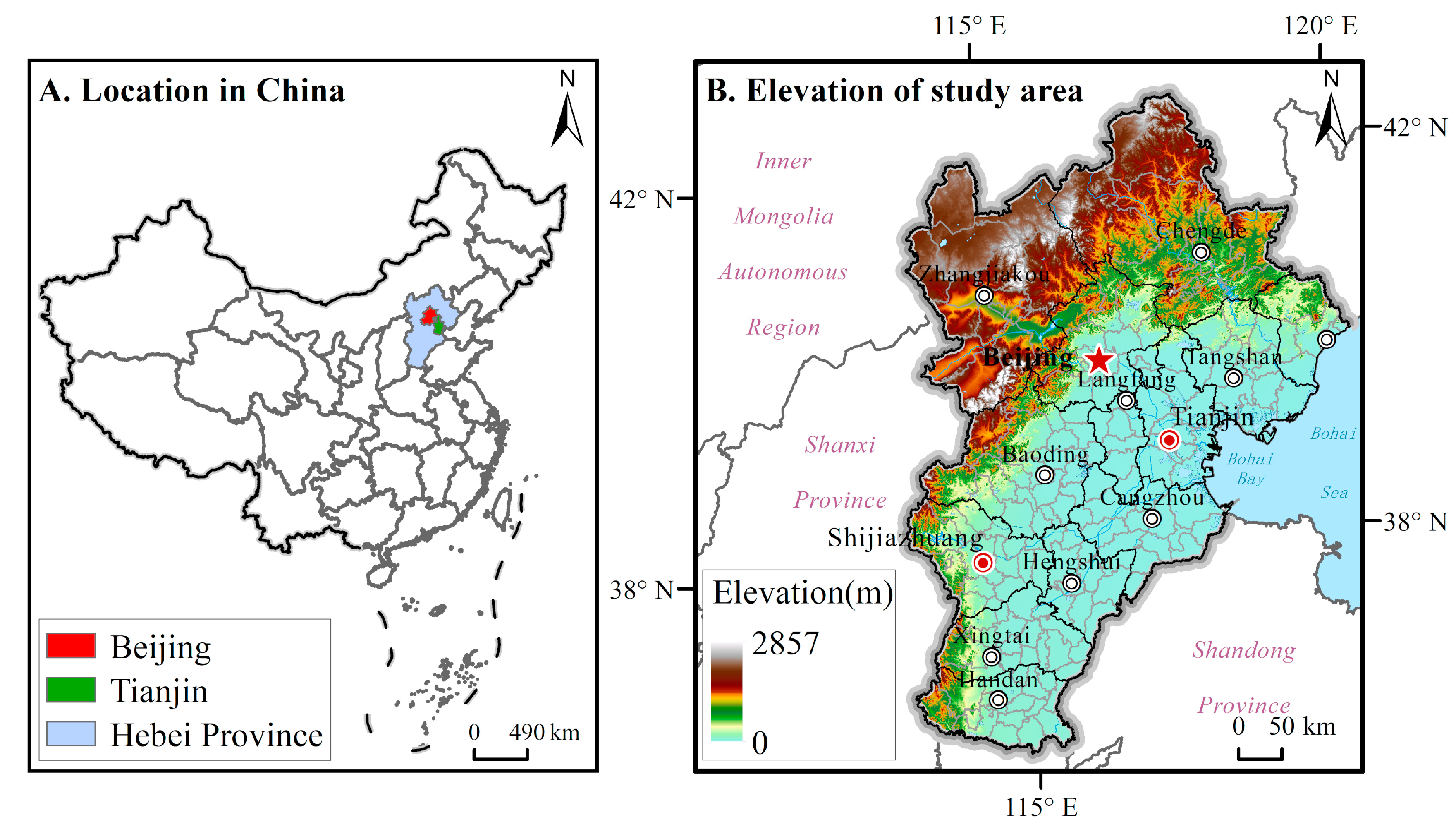



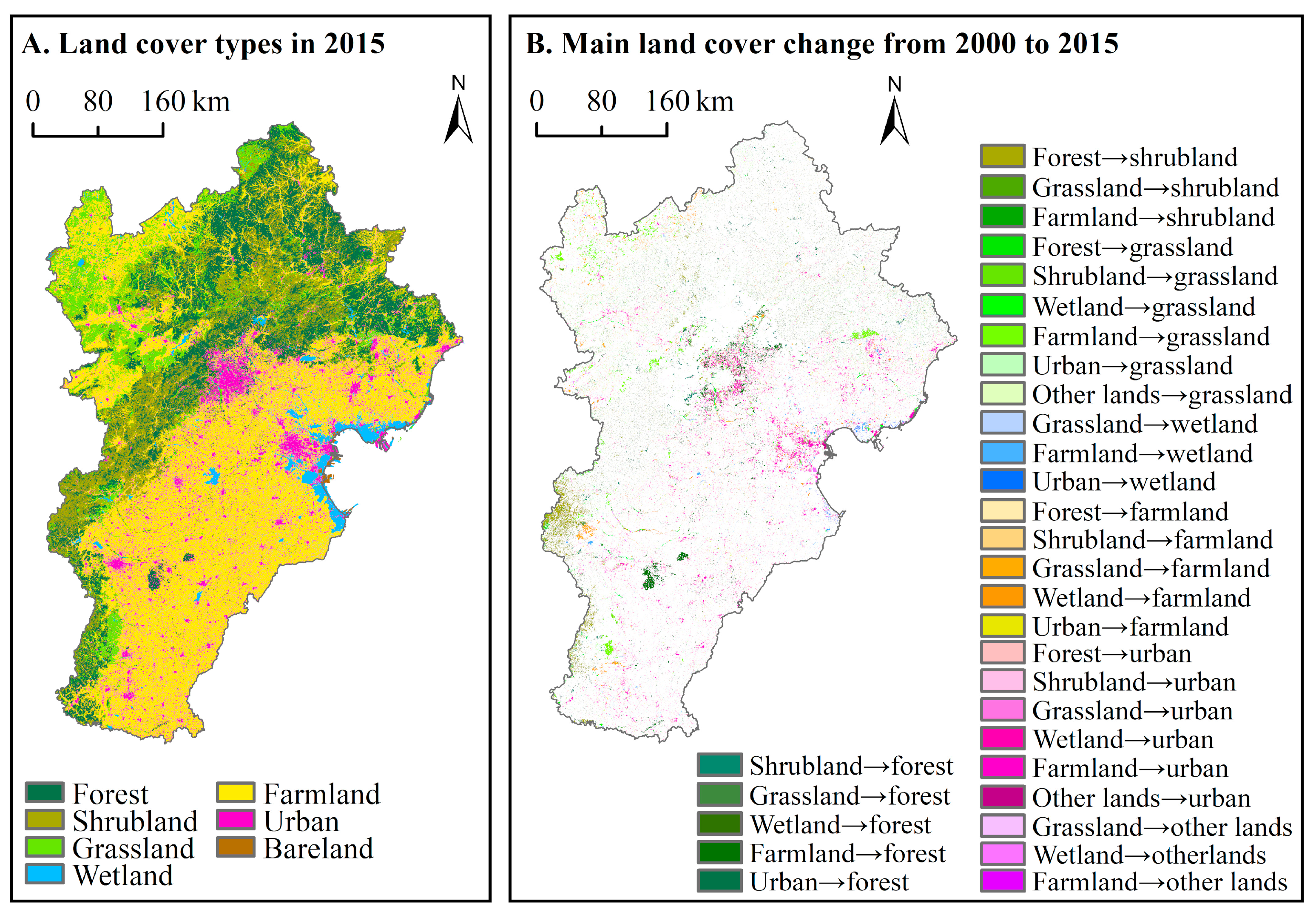
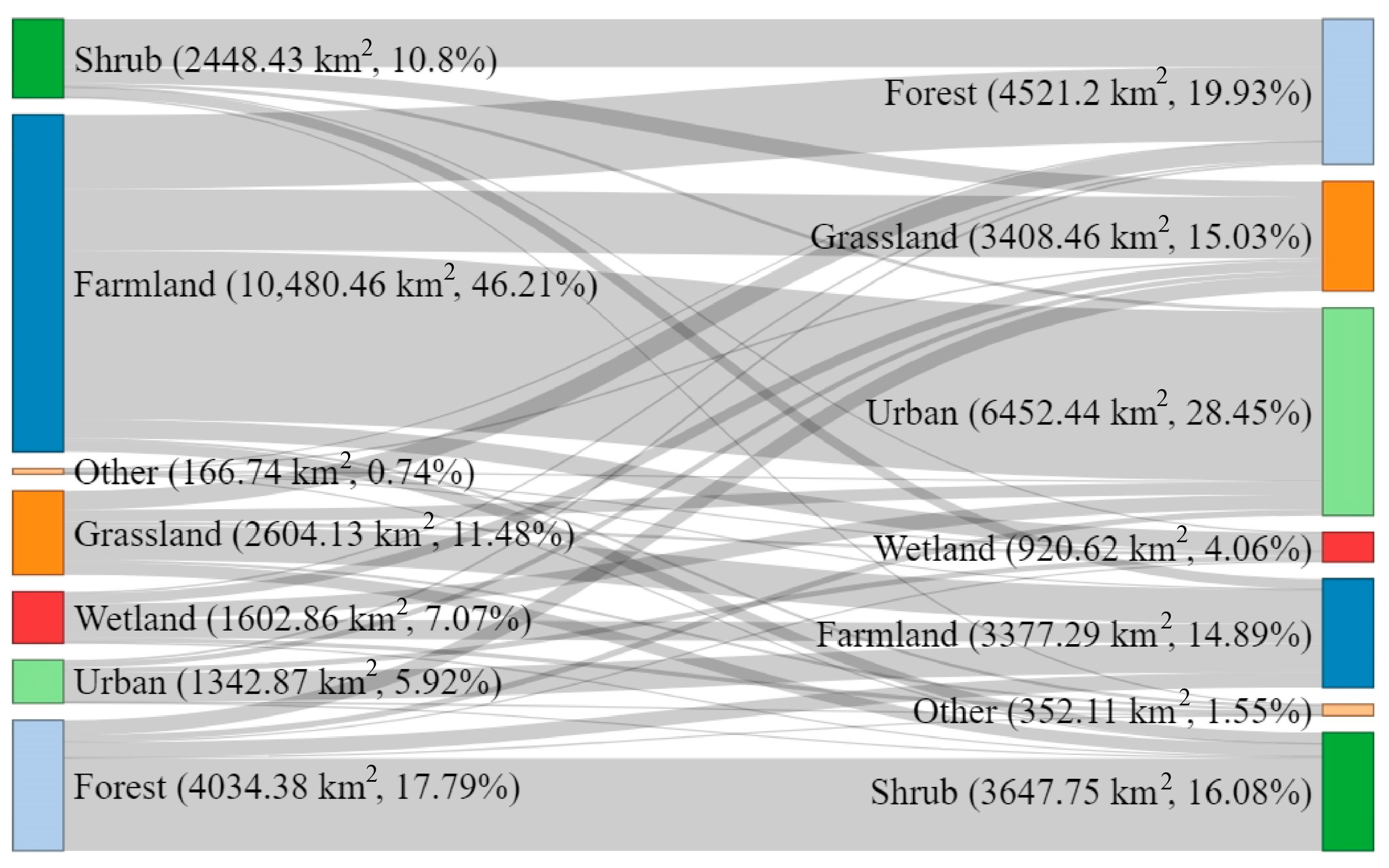
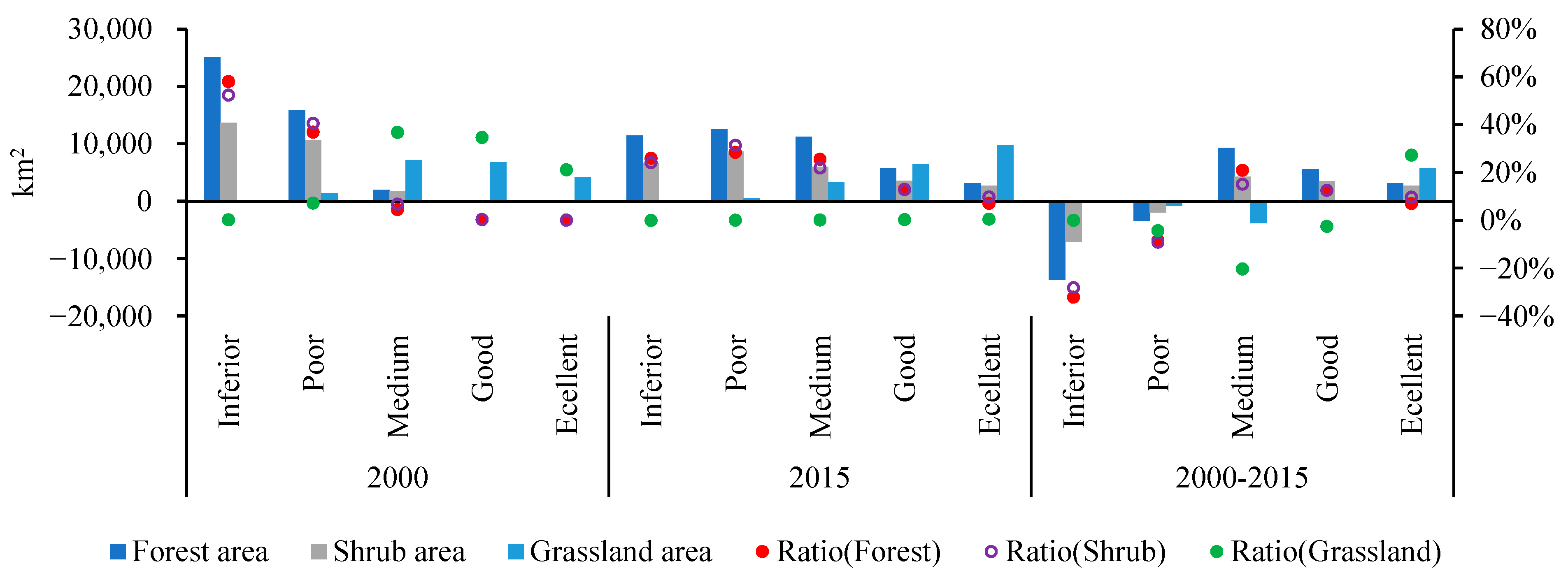


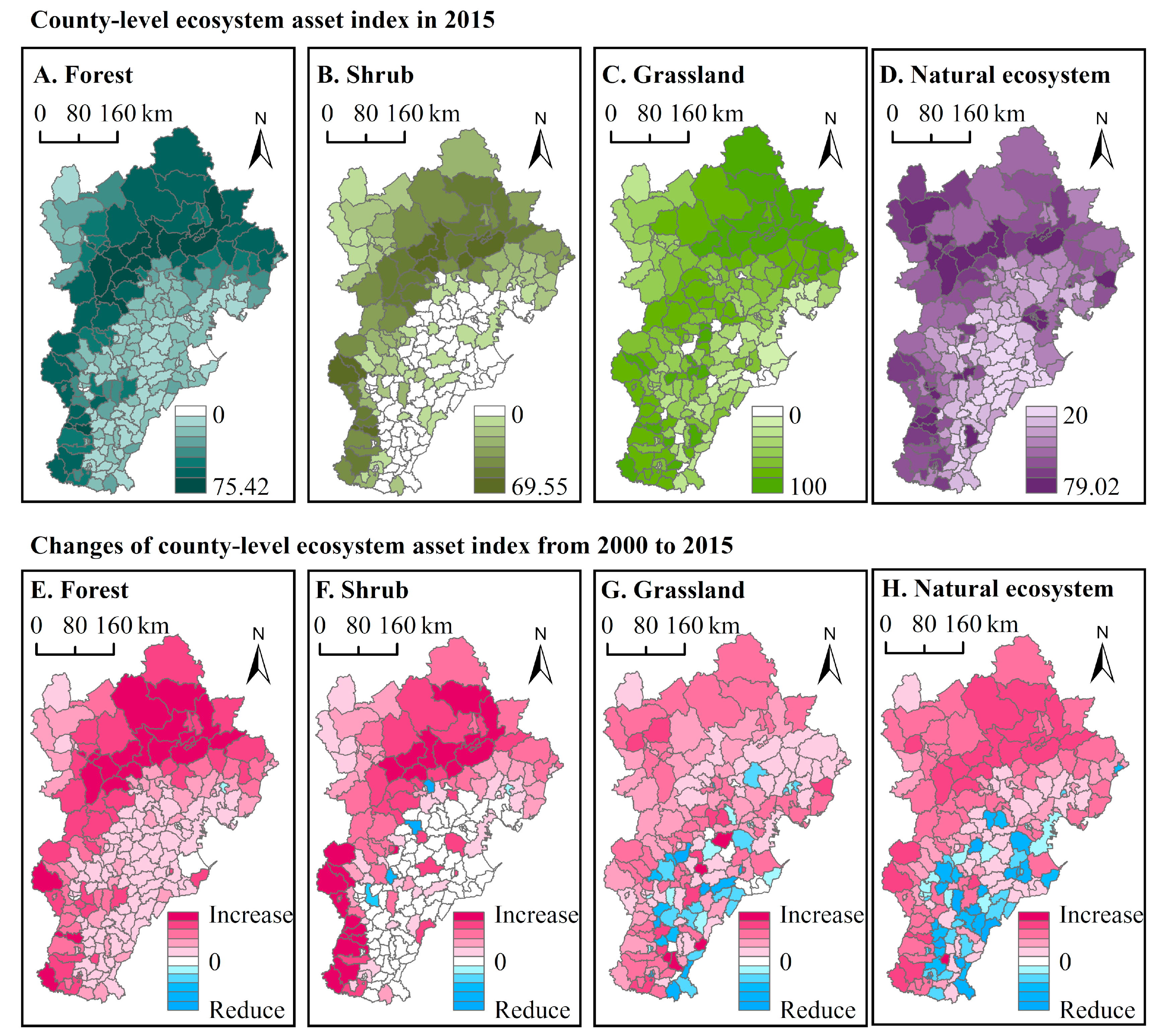
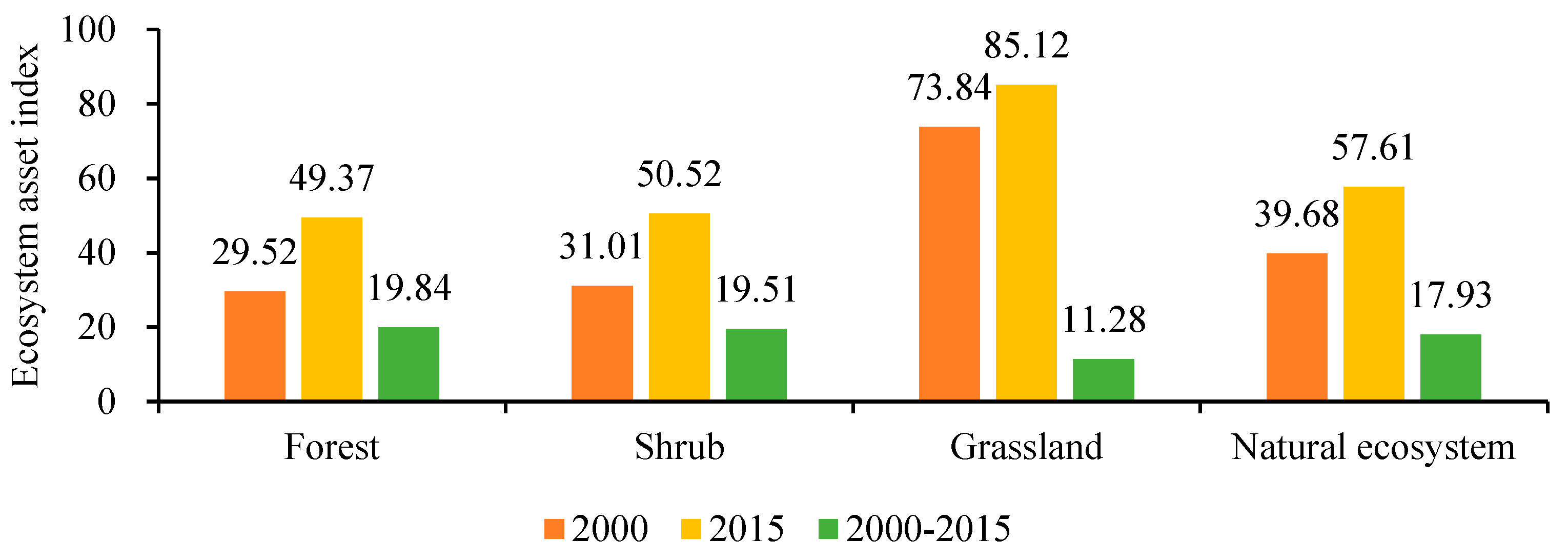


| Ecosystem Asset Type | Evaluating Indicator | Quality Grading Standard | ||||
|---|---|---|---|---|---|---|
| Excellent | Good | Medium | Poor | Bad | ||
| Forest | Relative biomass density | ≥80% | 60–80% | 40–60% | 20–40% | ≤20% |
| Shrub | Relative biomass density | ≥80% | 60–80% | 40–60% | 20–40% | ≤20% |
| Grassland | Vegetation Coverage | ≥80% | 60–80% | 40–60% | 20–40% | ≤20% |
| Ecosystem Degradation Type | Land Transfer Type | Area/km2 | Total Area/km2 | Ratio |
|---|---|---|---|---|
| Land urbanization | Farmland→urban | 5266.50 | 6452.44 | 45.15% |
| Wetland→urban | 464.19 | |||
| Grassland→urban | 377.67 | |||
| Forest→urban | 188.24 | |||
| Shrubland→urban | 116.29 | |||
| Other lands→urban | 39.55 | |||
| Cultivated land reclamation | Grassland→farmland | 1077.57 | 3355.8 | 23.48% |
| Urban→farmland | 895.90 | |||
| Wetland→farmland | 593.26 | |||
| Forest→farmland | 474.77 | |||
| Shrubland→farmland | 314.30 | |||
| Deforestation | Forest→shrubland | 2847.52 | 3337.62 | 23.36% |
| Forest→grassland | 469.83 | |||
| Forest→other lands | 20.27 | |||
| Vegetation destruction | Shrubland→grassland | 495.89 | 598.41 | 4.19% |
| Grassland→other lands | 87.24 | |||
| Shrubland→other lands | 15.28 | |||
| Wetland atrophy | Wetland→grassland | 316.50 | 545.41 | 3.82% |
| Wetland→other lands | 131.50 | |||
| Wetland→forest | 60.80 | |||
| Wetland→shrubland | 36.61 | |||
| Total | 14,289.68 | 63.01% |
| Ecosystem Restoration Type | Land Transfer Type | Area/km2 | Total Area/km2 | Ratio |
|---|---|---|---|---|
| Returning farmland to forest, grass and wetland | Farmland→forest | 2303.76 | 5213.96 | 62.14% |
| Farmland→grassland | 1902.95 | |||
| Farmland→wetland | 576.33 | |||
| Farmland→shrubland | 344.36 | |||
| Farmland→other lands | 86.56 | |||
| Afforestation | Shrubland→forest | 1492.90 | 2156.64 | 25.70% |
| Grassland→forest | 584.53 | |||
| Urban→forest | 72.76 | |||
| Other lands→forest | 6.45 | |||
| Vegetation restoration | Grassland→shrubland | 380.68 | 642.55 | 7.66% |
| Urban→grassland | 159.89 | |||
| Other lands→grassland | 63.40 | |||
| Urban→shrubland | 31.98 | |||
| Other lands→shrubland | 6.60 | |||
| Wetland restoration | Urban→wetland | 171.08 | 344.29 | 4.10% |
| Grassland→wetland | 96.44 | |||
| Forest→wetland | 33.75 | |||
| Other lands→wetland | 29.25 | |||
| Shrubland→wetland | 13.77 | |||
| Cultivated land reclamation | Other lands→farmland | 21.49 | 21.49 | 0.26% |
| Natural ecosystem restoration | Urban→other lands | 11.26 | 11.26 | 0.13% |
| Total | 8390.19 | 36.99% |
| Ecosystem Type | Landscape Fragmentation Index | Ecosystem Type | Landscape Fragmentation Index | ||||
|---|---|---|---|---|---|---|---|
| 2000 | 2015 | Increment | 2000 | 2015 | Increment | ||
| Forest | 0.1815 | 0.1829 | 0.0013 | Shrub | 0.1097 | 0.1143 | 0.0046 |
| Grassland | 0.0812 | 0.0844 | 0.0032 | Wetland | 0.0278 | 0.0261 | −0.0017 |
| Farmland | 0.4230 | 0.3919 | −0.0311 | Urban | 0.0747 | 0.0967 | 0.022 |
| Other lands | 0.0021 | 0.0038 | 0.0017 | ||||
| Time | Quality | Forest/km2 | Ratio/% | Shrub/km2 | Ratio/% | Grassland/km2 | Ratio/% |
|---|---|---|---|---|---|---|---|
| 2000 | Inferior | 25,065.81 | 58.08 | 13,631.19 | 52.38 | 46.88 | 0.24 |
| Poor | 15,900.38 | 36.84 | 10,556.38 | 40.56 | 1398.06 | 7.2 | |
| Medium | 1964.69 | 4.55 | 1752.31 | 6.73 | 7145.88 | 36.79 | |
| Good | 176.63 | 0.41 | 74.75 | 0.29 | 6731.5 | 34.65 | |
| Excellent | 47.56 | 0.11 | 9.56 | 0.04 | 4102.25 | 21.12 | |
| 2015 | Inferior | 11,416.75 | 25.98 | 6622.44 | 24.18 | 35.5 | 0.18 |
| Poor | 12,488.19 | 28.42 | 8593 | 31.37 | 584.44 | 2.89 | |
| Medium | 11,210.88 | 25.51 | 5990.5 | 21.87 | 3326.44 | 16.45 | |
| Good | 5691.19 | 12.95 | 3514.31 | 12.83 | 6496.81 | 32.12 | |
| Excellent | 3132.94 | 7.13 | 2669.63 | 9.75 | 9782.69 | 48.37 | |
| 2000–2015 | Inferior | −13,649.06 | −32.1 | −7008.75 | −28.2 | −11.38 | −0.07 |
| Poor | −3412.19 | −8.42 | −1963.38 | −9.19 | −813.63 | −4.31 | |
| Medium | 9246.19 | 20.96 | 4238.19 | 15.14 | −3819.44 | −20.34 | |
| Good | 5514.56 | 12.54 | 3439.56 | 12.54 | −234.69 | −2.53 | |
| Excellent | 3085.38 | 7.02 | 2660.06 | 9.71 | 5680.44 | 27.25 |
Publisher’s Note: MDPI stays neutral with regard to jurisdictional claims in published maps and institutional affiliations. |
© 2022 by the authors. Licensee MDPI, Basel, Switzerland. This article is an open access article distributed under the terms and conditions of the Creative Commons Attribution (CC BY) license (https://creativecommons.org/licenses/by/4.0/).
Share and Cite
Cao, Y.; Kong, L.; Ouyang, Z. Characteristics and Driving Mechanism of Regional Ecosystem Assets Change in the Process of Rapid Urbanization—A Case Study of the Beijing–Tianjin–Hebei Urban Agglomeration. Remote Sens. 2022, 14, 5747. https://doi.org/10.3390/rs14225747
Cao Y, Kong L, Ouyang Z. Characteristics and Driving Mechanism of Regional Ecosystem Assets Change in the Process of Rapid Urbanization—A Case Study of the Beijing–Tianjin–Hebei Urban Agglomeration. Remote Sensing. 2022; 14(22):5747. https://doi.org/10.3390/rs14225747
Chicago/Turabian StyleCao, Yanni, Lingqiao Kong, and Zhiyun Ouyang. 2022. "Characteristics and Driving Mechanism of Regional Ecosystem Assets Change in the Process of Rapid Urbanization—A Case Study of the Beijing–Tianjin–Hebei Urban Agglomeration" Remote Sensing 14, no. 22: 5747. https://doi.org/10.3390/rs14225747
APA StyleCao, Y., Kong, L., & Ouyang, Z. (2022). Characteristics and Driving Mechanism of Regional Ecosystem Assets Change in the Process of Rapid Urbanization—A Case Study of the Beijing–Tianjin–Hebei Urban Agglomeration. Remote Sensing, 14(22), 5747. https://doi.org/10.3390/rs14225747





